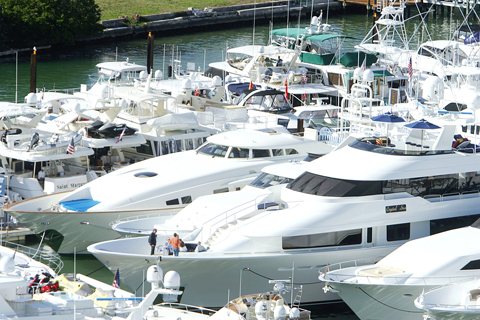On the sun-splashed Florida peninsula, the US foreclosure crisis is sinking lavish lifestyles on land and at sea as luxury yacht owners increasingly find themselves high and dry.
The listing for a recent attractive property swallowed up by the crisis appeared to be a sea-front condominium: two bedroom/two bath, outdoor grill, water views, elegant and spacious. Satellite TV and temperature-controlled wine cabinet included.
It was a 18.3m yacht, docked amid a crush of other luxury marine toys at a Fort Lauderdale boat yard.

PHOTO: AFP
“We’re busting at the seams,” said Jason Lessnau, recovery manager for National Liquidators, the largest marine repossession company in the US.
The longer the mortgage crisis lasts, the more yachts end up in his boat yard — double and triple parked.
“Our sales numbers are up, our recovery numbers, every single number you can think of is through the roof for us right now,” he said.
With its deflated real estate market, Florida has become emblematic of the US housing woes after the real estate bubble saw prices spike then collapse.
Now, as the recession deepens and home prices keep diving in value, the problem is creeping beyond homes and high-rises, and prompting a hike in boat foreclosures too.
Experts say many boat owners made the same mistakes as homeowners.
The easy credit that fueled the real estate boom also brought carefree spending and no-money-down loans for maritime toys. Boats tend to lose their value more quickly than cars, so many owners soon owed more than their boats were worth.
The economic slump pushed prices still lower, but the bills kept rolling in.
Boat owners usually fall behind on their payments when they are hit by job loss — another side-effect of the economic downturn — or divorce. Like car loans, boat loans allow the bank to recover its collateral if the owner defaults.
A stark measure of the trend comes right off resellers’ inventory sheets. National Liquidator president Bob Toney says boat repossessions have nearly quadrupled over the last two years. He’s leasing four additional boatyards to keep up.
“A 350 percent increase in business is not all fun and games,” said Toney, who has seen many longtime clients and associates hurt by the downturn. “It creates some heartburn and stomach acid once in a while.”
Toney has also noticed a shift in the size of the boats repossessed. National Liquidators typically receives repossession orders for boats between 6.1m and 11.5m in length. They range from flashy speedboats to weather-worn sailboats to sturdy cruisers.
But there are several luxury yachts in the yard these days, suggesting the rich are not insulated.
“We’re seeing more 60 and 70-footers [18.3m and 21.3m] and a few in the mega-yacht field, 100-plus [30.5m],” Toney said.
“Some of those are owned by people you read about in the newspaper,” he said.
About half of repossessed boats are turned over voluntarily by owners, sometimes stripped of valuable equipment, such as radar systems. The other half are “involuntary” transfers, meaning repossession teams tow them away quietly in the middle of the night.
Repossession teams usually arrive in low-profile dinghies.
One person sets up the tow lines while another cuts the boat free and a third person disconnects electrical lines. A seasoned repo team can tow a boat off a dock in less than 60 seconds.
Sometimes the boats still contain the trappings of yesterday’s excess: discarded champagne bottles, drugs, a jet ski.
Lessnau, the recovery manager, said larger boats often end up overseas after auction — buyers with euros see especially deep savings.
“They can purchase at an instant discount and ship the boat back to Europe. That’s still a strong market,” he said.
Strolling through the boat yard, Fabienne Varela and her husband said even in dollar-terms they have seen prices slashed almost in half since the housing collapse.
While they feel bad for those losing their boats, “we’re trying to take advantage of the economy,” Varela said. “That’s what [US President Barack] Obama says: spend, spend, spend.”

LIMITS: While China increases military pressure on Taiwan and expands its use of cognitive warfare, it is unwilling to target tech supply chains, the report said US and Taiwan military officials have warned that the Chinese People’s Liberation Army (PLA) could implement a blockade within “a matter of hours” and need only “minimal conversion time” prior to an attack on Taiwan, a report released on Tuesday by the US Senate’s China Economic and Security Review Commission said. “While there is no indication that China is planning an imminent attack, the United States and its allies and partners can no longer assume that a Taiwan contingency is a distant possibility for which they would have ample time to prepare,” it said. The commission made the comments in its annual

DETERMINATION: Beijing’s actions toward Tokyo have drawn international attention, but would likely bolster regional coordination and defense networks, the report said Japanese Prime Minister Sanae Takaichi’s administration is likely to prioritize security reforms and deterrence in the face of recent “hybrid” threats from China, the National Security Bureau (NSB) said. The bureau made the assessment in a written report to the Legislative Yuan ahead of an oral report and questions-and-answers session at the legislature’s Foreign Affairs and National Defense Committee tomorrow. The key points of Japan’s security reforms would be to reinforce security cooperation with the US, including enhancing defense deployment in the first island chain, pushing forward the integrated command and operations of the Japan Self-Defense Forces and US Forces Japan, as

IN THE NATIONAL INTEREST: Deputy Minister of Foreign Affairs Francois Wu said the strengthening of military facilities would help to maintain security in the Taiwan Strait Japanese Minister of Defense Shinjiro Koizumi, visiting a military base close to Taiwan, said plans to deploy missiles to the post would move forward as tensions smolder between Tokyo and Beijing. “The deployment can help lower the chance of an armed attack on our country,” Koizumi told reporters on Sunday as he wrapped up his first trip to the base on the southern Japanese island of Yonaguni. “The view that it will heighten regional tensions is not accurate.” Former Japanese minister of defense Gen Nakatani in January said that Tokyo wanted to base Type 03 Chu-SAM missiles on Yonaguni, but little progress

NO CHANGES: A Japanese spokesperson said that Tokyo remains consistent and open for dialogue, while Beijing has canceled diplomatic engagements A Japanese official blasted China’s claims that Japanese Prime Minister Sanae Takaichi has altered Japan’s position on a Taiwan crisis as “entirely baseless,” calling for more dialogue to stop ties between Asia’s top economies from spiraling. China vowed to take resolute self-defense against Japan if it “dared to intervene militarily in the Taiwan Strait” in a letter delivered Friday to the UN. “I’m aware of this letter,” said Maki Kobayashi, a senior Japanese government spokeswoman. “The claim our country has altered its position is entirely baseless,” she said on the sidelines of the G20 summit in Johannesburg on Saturday. The Chinese Ministry